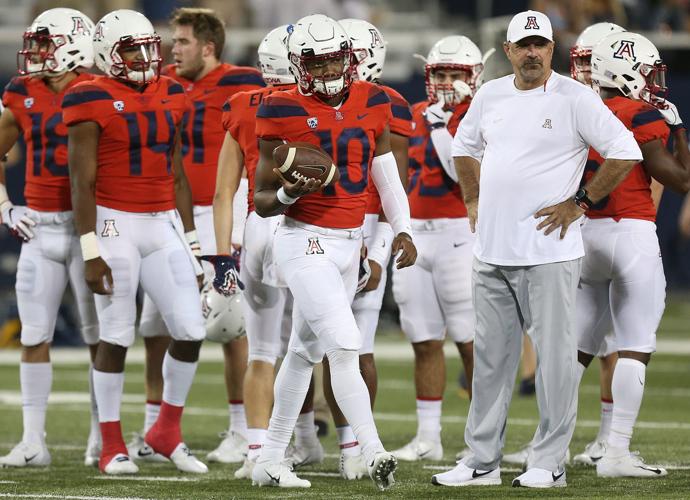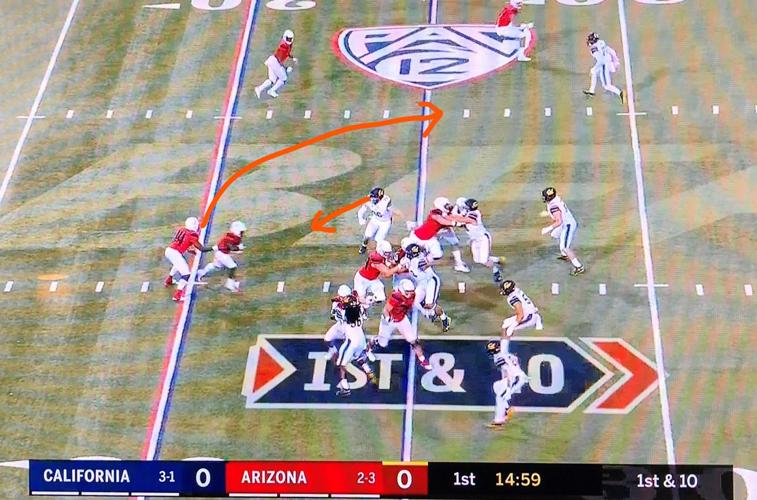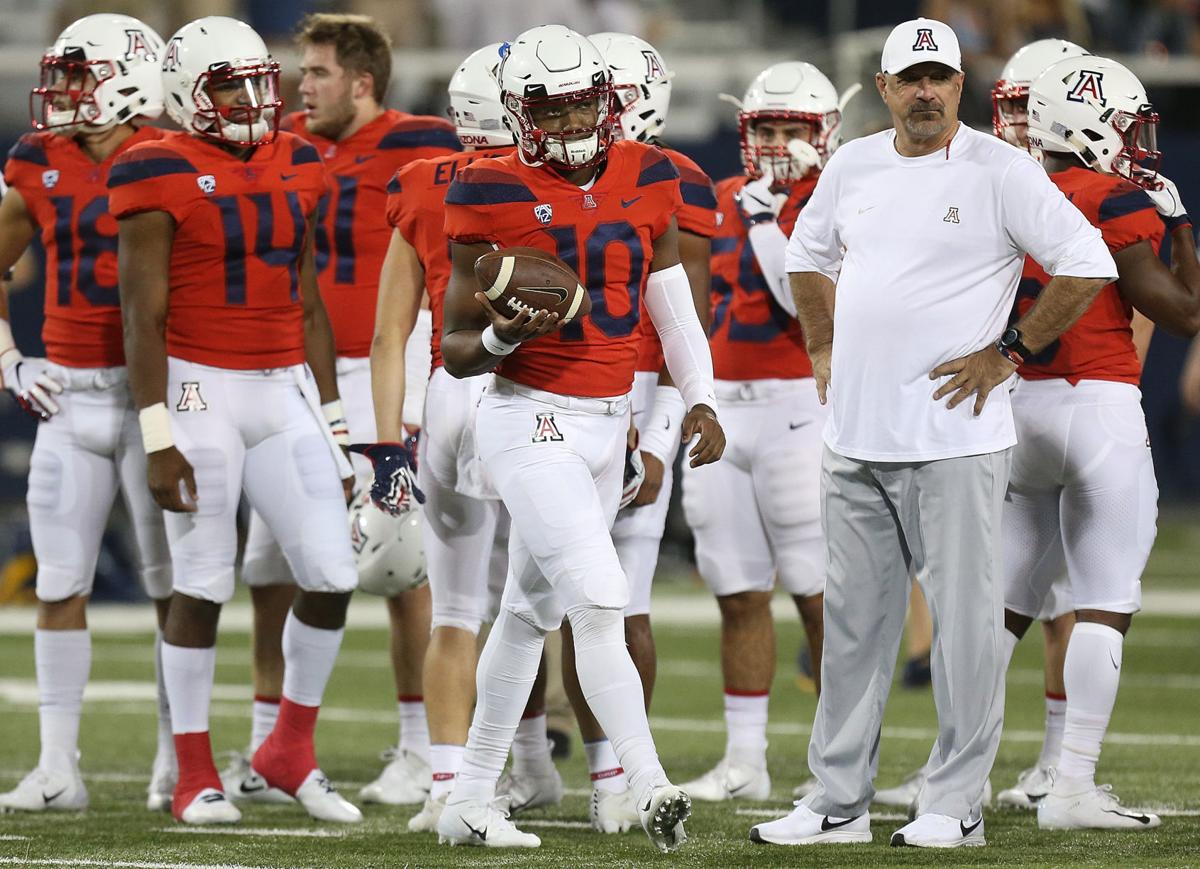Every week throughout the season, we’ll take a look back at the Arizona Wildcats’ previous game after re-watching it via the TV broadcast. Here are five key takeaways from the UA’s 24-17 victory over Cal on Saturday:
1. MORE THAN MAZZONE

Khalil Tate had an opportunity to pull the ball and run on the first play of the game vs. Cal.
After a lackluster offensive performance – no points after the first quarter and no red-zone snaps at any juncture – Noel Mazzone’s critics were out in full force. Second-guessing the offensive coordinator is the lowest-hanging fruit. Mazzone isn’t above reproach. But as is often the case in football, Arizona’s offensive issues aren’t as obvious as you might think. One thing that became clear after reviewing the game: Khalil Tate needs to pull the ball more on zone-read plays. Based on the positioning and stance of the unblocked edge player, there were at least four instances where it appeared Tate should have pulled it – but didn’t. When he kept the ball on third-and-9 at the UA 4-yard line in the fourth quarter, not only did Tate gain 17 yards but he re-established the threat of his running. On an 8-yard rush by J.J. Taylor two plays later, the edge defenders froze; they had to stay home in case Tate ran. If you’re going to run a heavy zone-read scheme, the QB has to keep the defense honest. It’s a great way to aid an offensive line that has struggled the past two weeks. Tate still isn’t quite right physically; he lacks the explosiveness he showed last year. But gaining 5-10 yards – or 17 – can go a long way. Circling back to Mazzone, one area where he could stand to be more creative is on third-and-short. Sprinkling in bootlegs or waggle passes would be an effective wrinkle.
2. ADJUSTMENTS ARE SERVED
SCOTTIE YOUNG!Pick 6⃣ pic.twitter.com/EzoLlaVexS
— Arizona Football (@ArizonaFBall) October 7, 2018
Mazzone’s coordinator cohort, Marcel Yates, made critical adjustments that fueled the Wildcats’ stellar defensive performance in the second half. The biggest one: Calling for more three-man rushes backed by zone coverage. The three-man rush has been an object of scorn in this space and elsewhere. But it can be an effective ploy against a relatively inexperienced dual-threat quarterback like Cal’s Brandon McIlwain. You don’t want to go flying up the field against a scrambler. Arizona rushed only three at least 10 times in the second half. Playing zone also helps to keep defenders’ eyes on the quarterback. Cal and McIlwain exploited man coverage in the first half out of empty-backfield sets, often motioning tailback Patrick Laird, who would take a linebacker out of the box. On both of McIlwain’s first-half TD runs, the middle of the defense was vacated. Arizona rushed three and dropped eight on Scottie Young Jr.’s decisive pick-six. Tristan Cooper and Young bracketed intended receiver Ian Bunting, who did not see what McIlwain saw. Bunting ran a stop route; McIlwain expected an out cut. He threw the ball right to Young, who snared it and strolled 24 yards into the end zone.
3. BIG DIFFERENCE
I’m here for the PJ Johnson experience pic.twitter.com/vk6Q4znIz9
— Michael Lev (@MichaelJLev) October 7, 2018
The Wildcats are allowing an average of 18.3 points in Pac-12 games – their best three-game stretch to begin league play since 2010. (Their next-lowest average since then, per UA Sports Information: 31.0.) What’s been the biggest difference since the miserable Houston performance and the so-so effort against Southern Utah? It starts up front. PJ Johnson’s return and move to defensive end have had a sizable impact – pun intended. After Justin Belknap and Jalen Cochran got hurt, the staff moved the 335-pound Johnson one spot over. He has displayed shockingly nimble feet and the ability to chase down plays run to the opposite side. Meanwhile, defensive tackle Dereck Boles is playing his best ball since coming to Arizona last year. Boles left the Houston game because of injury and didn’t look quite right against Southern Utah. In the past two games, he has nine tackles, including one for a loss, and a fumble recovery. On the Wildcats’ fourth-down stop deep in their territory in the fourth quarter, Boles fought off a block by Cal’s Patrick Mekari to get the first hit on McIlwain. Tony Fields II and Finton Connolly provided support. Fields and Colin Schooler can’t do what they do without help from the big fellas.
4. THIS TIME IT’S PERSONNEL
At a minimum, this is unnecessary roughness. To me (and the whole FS1 crew, including Dean Blandino) it was targeting. What’s the point of having those rules - for safety - if you’re not going to enforce them? pic.twitter.com/BxGR9w8LSS
— Michael Lev (@MichaelJLev) October 7, 2018
Each week we provide some notes on individual players, so here goes … Tailback Anthony Mariscal gave a valiant effort as the de facto No. 2 tight end in place of the injured Jamie Nunley, even serving as a lead blocker at times. … When run plays don’t work, it isn’t just the offensive line; tight end Bryce Wolma struggled to hit his targets and needs to improve his blocking efficiency. … If the staff is thinking about shaking up the O-line, don’t expect it to happen this week with one fewer day to prep for a Friday-night affair at Utah. … Kudos to junior walk-on Lee Anderson III, who began the game as the backup “Mike” linebacker but finished at the “Stud” position after Kylan Wilborn got hurt. Anderson drew a holding penalty, shared a sack and recovered a fumble on special teams. … Rising redshirt freshman Jalen Harris is showing he isn’t just a pass rusher; he’s starting to make plays against the run and in pass coverage. … Safety Jarrius Wallace had a sneaky-good game defending the run and pass. … It’s unfathomable that targeting wasn’t enforced in the third quarter against Cal’s Deon White, who blindsided defenseless Wildcat Isaiah Hayes with a blow to the neck/head area.
5. MIDSEASON ASSESSMENT
The good news: For all its faults, Arizona is 2-1 in Pac-12 play. The bad: The Wildcats are 3-3 overall. Considering that some projected them to lose three games the entire season, that’s not a great place to be. But it could be worse: A loss to Cal would have dropped Arizona to 2-4 ahead of back-to-back road games. Now, if the Wildcats can get a split against Utah and UCLA, they’ll be 4-4 heading into the final quarter of the season. The opponents after the Bruins are tough: Oregon, Colorado, Washington State and Arizona State. But three of the four games are at home, and that final stretch is broken up by Arizona’s long-awaited and much-needed bye. There’s no other opportunity to let Tate rest his ankle unless Kevin Sumlin decides to sit him – a move that makes much less sense in Salt Lake City or Pasadena. No matter what’s going on at quarterback, re-establishing the run is a must. If you can run the ball and play good defense – and the Wildcats are certainly showing signs of the latter – you can win on the road. Arizona must win one of the next two to position itself for a bowl berth.






